Philips 40PFL7007T Review
Philips 40PFL7007T
As an all-round package, this is arguably Philips' best 2012 TV yet.
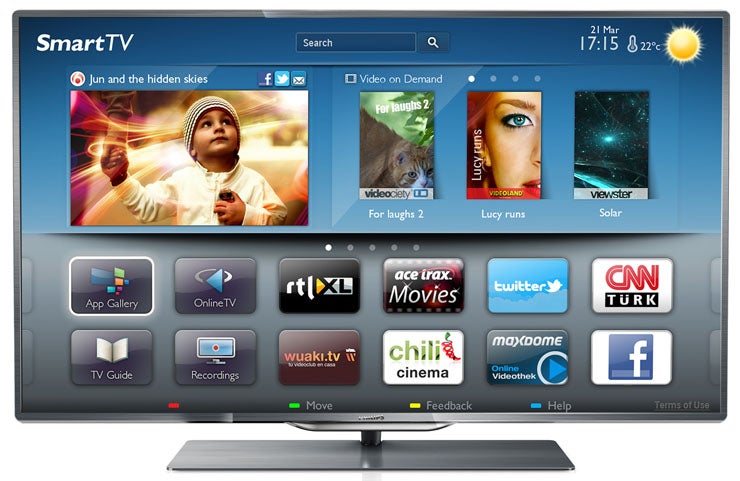
Verdict
Pros
- Excellent 2D and 3D pictures for the most part
- Gorgeous design
- Excellent audio for a skinny TV
Cons
- Online service needs more video services
- Requires care with its picture settings
- A couple of minor 3D niggles
Key Specifications
- Review Price: £999.00
- 40in LCD TV with edge LED lighting
- active 3D playback
- multimedia playback via USB
- Net TV online service
- 800Hz 'Perfect Motion Rate'
Introduction
So far we’ve looked at a couple of 6007 models from Philips’ new TV series, an 8007 model, and a 9707. Which means, according to our brilliant maths, that we’ve somehow missed the 7007 series. So let’s put that right straight away, by running our eye over the 40in 40PFL7007.
Immediately this upper mid-range model sets itself apart from the 6007 series courtesy of a startlingly extravagant design. For starters its bezel is spectacularly slim. But what little there is of it is given real punch by the application of a glinting metallic finish.
Philips 40PFL7007T – Design
The set’s rear is trim too, and boasts a startling white finish that makes a refreshing change to the usual boring blacks and greys. Though of course, you’ll generally get the best results from a TV if you look at its front rather than its backside…
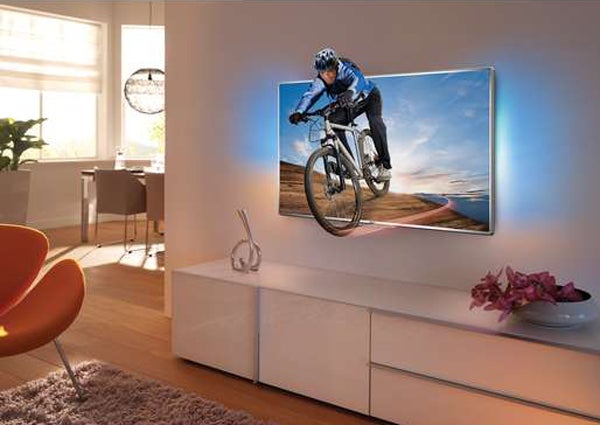
That said, its slimness and white colour aren’t the only eye-catching things about the 40PFL7007T’s posterior. Four strips of LEDs down each side alert us to Philips’ Ambilight system, which casts out coloured light pools to either side of the TV that can, if you wish, automatically match the colours in the picture you’re watching.
Philips 40PFL7007T – Ambilight and Connectivity
Ambilight takes some getting used to, and we guess some people will never warm to it. But personally we’ve grown rather fond of the way its effects reduce the stress on your eyes – especially if you’re watching in a darkened room.
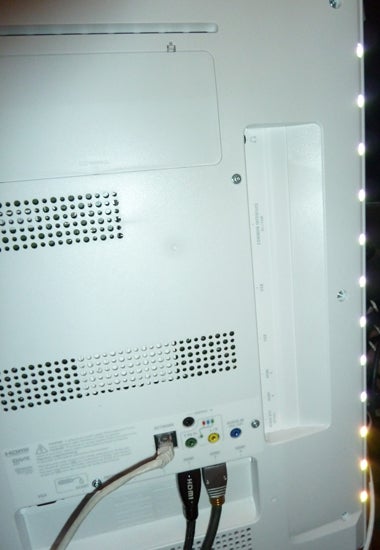
Connections, meanwhile, are all mounted sideways on, allowing you easy access to them even if you’ve got the TV hung on a wall. They’re also reasonably abundant, with highlights including five HDMIs (one more than you’ll find from any other brand this season), three USBs for playing back a good range of video, photo and music file formats, and both LAN and integrated W-Fi options for accessing either files stored on a networked computer or Philips’ latest NetTV online service.
Philips 40PFL7007T – Online services
NetTV arrives with a new, improved but still rather inefficient (in space and navigation terms) onscreen interface; a rather brilliant QWERTY keyboard built onto the remote control’s reverse side; and more content than we saw on it last year.
However, despite the recent addition of Acetrax and Blinkbox to a service roster that already includes the BBC iPlayer, iConcerts, YouTube, Viewster, CNBC Real Time, Absolute Radio, Funspot, Skype, Twitter, Facebook, NetTV still feels a little off the online pace being set by the likes of Samsung, Sony, LG and Panasonic. 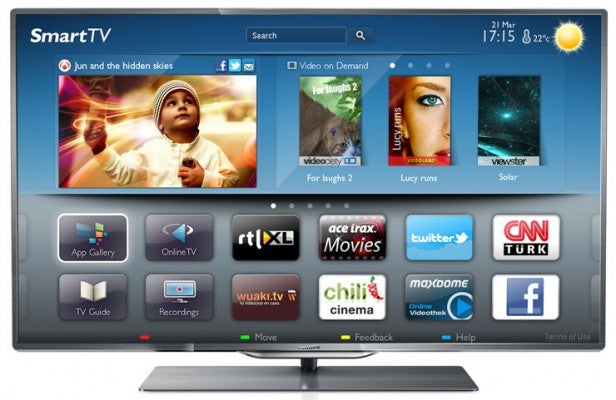
To be clear, we’re not bemoaning the absence of rubbish one-screen games and endless trivial infotainment apps that take up so much space on particularly the Korean brands’ online TV services. What we do want to see Philips bringing in, though, is more quality video streaming fare like the ITVplayer, LoveFilm and Netflix.
Philips 40PFL7007T – Picture tech
A TV as short of chassis bulk as the 40PFL7007T inevitably uses edge LED lighting to deliver its pictures. The implementation in the 40PFL7007T uses the same sort of microdimming automatic picture optimisation technology Samsung’s TVs use, while other aids to picture quality come from an ‘800Hz’ Perfect Motion Rate (meaning a 200Hz panel with a scanning backlight and frame interpolation) and Philips’ Pixel Precise HD video processing.
The use of the Pixel Precise HD system is a significant factor in placing the 40PFL7007T below the 9707 and 8007 models in Philips’ 2012 pecking order, for this processing system is far less powerful than the Perfect Pixel HD system found in the two higher-end models. This isn’t necessarily a reason for despondency, though, for Pixel Precise HD has delivered some fine results on the 6007 models, and here it’s backed up by a more advanced motion handling system than the 6007 models have.
Philips 40PFL7007T – 3D specs
While the 40PFL7007T might not have the same level of video processing as the 8007s and 9707s, though, it does get the same active (or ‘Max’ in Philips’ terminology) 3D system versus the passive system used in the 6007T series. Normally the resolution junky in us would be pleased about this, though here we’ll have to reserve judgment given that the active system on the 9707 model suffered a lot of crosstalk ghosting noise while the passive system on the 6007 models actually worked terrifically well.
Two other points to mention while we’re on the subject of 3D are 1) that you get one pair of 3D glasses free with the TV and 2) that the ‘dual picture’ technology associated with 3D is also used on the 40PFL7007T to enable two gamers to enjoy full screen gaming simultaneously courtesy of a special mode on the glasses. 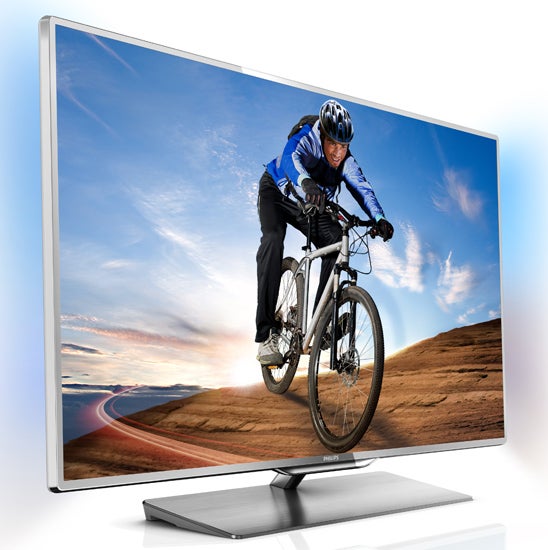
Philips 40PFL7007T – HD Image Quality
Firing the 40PFL7007T up with some HD broadcasts from a Sky HD receiver and the TV’s own tuner, it’s immediately obvious that it’s another classy Philips performer. Especially striking is the amount of detail apparent in high-quality HD feeds. In fact, they look so sharp for much of the time that they look more like low-compression Blu-rays than compressed digital broadcasts. This is especially true if you use the Pixel Precise HD’s Advanced Sharpness tool – though even if you don’t (it can, after all, cause images to look a little gritty and edges to appear slightly stressed) images still look remarkably crisp for a set two steps off the top of Philips’ latest TV ladder.
Colour performance
Helping the TV achieve its sense of extreme clarity is the subtlety with which it renders colours. Even the most gradual and subtle blends are rendered pretty much flawlessly, leaving no patchiness or striping and ensuring that you get the full impact of what’s clearly a very expansive colour palette.
Motion is well handled for the most part. Even using the Perfect Natural Motion system on its least powerful setting, judder and resolution loss over moving objects are pretty much removed. Though since this processing can cause a little flickering side effect over very fast motion (something the more powerful Perfect Pixel HD system better avoids), AV purists will be pleased to hear that judder remains a minimal problem even without the motion processing in play. And while there is noticeably more resolution lost when showing moving objects without Perfect Natural Motion switched on, it’s still not by any means a severe enough problem to be a deal breaker.
Impressive contrast
Especially as the 40PFL7007T excels in another area where traditionally we might expect an ultra – and we mean, ultra – slim edge LED to fail: contrast. For starters, the 40PFL7007T is able to underpin its pictures with a startlingly profound black level response that leaves black colours actually looking black rather than grey or blue as is so often the case.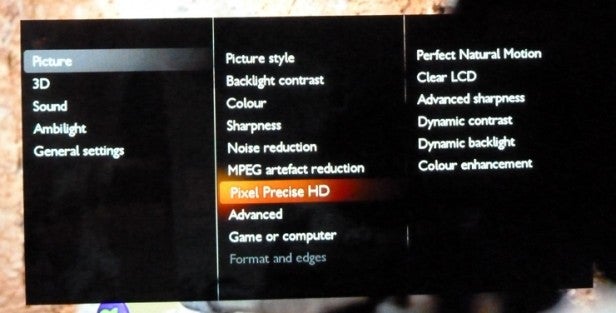
What makes this all the more exciting is the fact that the screen doesn’t have to remove nearly as much brightness from its pictures to achieve its punchy blacks as we would normally expect – a fact which enables some pleasingly potent colours and punchy whites to rest right alongside those inky blacks we’ve already mentioned.
Strong dark colours
The ability to deliver a good black colour also helps the 40PFL7007T produce other colours very naturally during dark scenes, as they avoid the grey or blue undertone that tends to infuse dark colours on TVs with less impressive black levels.
Yet more good news where the 40PFL7007T’s handling of dark scenes is concerned is how little backlight inconsistency and light ‘pooling’ there is. Clouds of extra brightness, especially around the edge of pictures, are common on edge LED TVs, especially those with bezels as thin as the one on show here. But while there are very faint traces of clouding in the 40PFL7007T’s corners, overall it keeps blacks looking impressively uniform – especially if you nudge the backlight contrast down a bit from its factory preset levels.
Philips 40PFL7007T – SD Image Quality
The quality of the image processing inside the 40PFL7007T, meanwhile, is arguably at its most obvious when watching standard definition. For starters it’s great to see that unlike many upscaling engines, the one in the 40PFL7007T doesn’t mess up colours, leaving them looking almost as naturally toned as they do with HD.
Philips 40PFL7007T – SD Image Quality cont.
The Pixel Precise HD engine also does a fine job of sharpening standard def sources up, leaving even usually soft fare like Bargain Hunt looking at least halfway HD. The 40PFL7007T isn’t quite as nifty at taking noise out of the picture during the upscaling process as the 8007 and 9707 models, on account of these latter models having a more powerful, faster processing engine. As a result, you should turn off all the 40PFL7007T’s sharpness-boosting tools for standard def viewing.
You might thus feel tempted to try the set’s NR routines, though these tend to make the picture look quite a bit softer. But whether you use the NR or not when watching standard def, overall you can rest assured that on those thankfully increasingly rare occasions where you find something you want to watch isn’t available in HD, then the 40PFL7007T will present it more than adequately.
The only significant problem with 2D pictures, really, so long as you’re careful with the set’s processing settings, is that if you’ve got the dynamic backlight option active, sudden transitions from dark to very bright material causes a quite distracting momentary flicker effect over the central third
or so of the picture. It crops up quite often if you use the ‘Best for Picture’ setting, and thankfully reduces considerably if you opt for the ‘Standard’ dynamic backlight setting. Because of this we tended to leave the
dynamic backlight feature switched off, especially if watching animated
material.
Philips 40PFL7007T – 3D Image Quality
Nervously switching our tests to 3D, the 40PFL7007T thankfully left us feeling impressed. The biggest surprise is that it doesn’t suffer with anywhere near as much crosstalk as Philips’ flagship 9707 Moth-Eye set. You have to let the TV warm up for a bit before watching 3D, and even then there are still traces of the tell-tale double ghosting noise from time to time. But the ghosting is neither as common nor as aggressive when it appears as it is on the 46PFL9707. The only reason we can come up with for this is that the PFL7007T and PFL8007T models both source their panels from a different place to where the PFL9707 comes from.
The relative lack of crosstalk on the 40PFL7007T allows you to bask in the full HD glories of 3D Blu-rays, lapping up their rich detail and sharply rendered sense of depth. Also helping the sense of clarity the 40PFL7007T delivers is its above average handling of motion with 3D material, even if you opt not to use the Natural Motion processing.
And there’s more. For while some active shutter glasses take substantial chunks out of 3D images’ brightness and colour saturations, the 40PFL7007T’s glasses only have a relatively minor dimming impact.
Minor 3D flaws
There are a couple of relatively minor issues with the 40PFL7007T’s 3D pictures though, beyond the very minor residual crosstalk mentioned earlier. First, in working harder to counter the dimming effect of the 3D glasses, the TV is more likely to exhibit traces of light leakage in its corners during dark scenes. Second, the little mid-screen flicker noted in the 2D section of the review feels more pronounced in 3D mode, making it more likely that you’ll choose to deactivate the dynamic backlight when watching 3D.
It’s worth briefly adding here, too, that the 40PFL7007T’s many picture processing options really need experimenting with in some depth if you’re to continually have them running to their best effect with different types of source material.
While the 40PFL7007T’s colour, contrast and sharpness make it a very strong gaming monitor, its gaming skills are slightly dented by a somewhat high average input lag figure of around 60ms which could potentially slightly impact your ‘twitch’ gaming abilities.
Philips 40PFL7007T – Audio
TVs as skinny as the 40PFL7007T tend to suffer for their aesthetics when it comes to their audio performance. But the 40PFL7007T has a nifty trick up its sleeve that helps it stand head and shoulders sonically above the super-slim TV hoi polloi. For one thing we neglected to mention during our description of the 40PFL7007T is that it builds its speakers into its stand.
This allows the TV to produce much more bass and a wider mid-range than TVs with speakers included in their bodies tend to manage. Yet crucially Philips has managed to manipulate the sound the speakers produce so that dialogue still sounds locked to the image, and not like it’s coming from the stand beneath it.
Verdict
Philips has already done some cracking TVs in the latter part of 2012. But the overall package of the 40PFL7007T, with its design, features, price and performance levels, makes it arguably our favourite new Philips TV yet.
How we test televisions
We test every TV we review thoroughly over an extended period of time. We use industry standard tests to compare features properly. We’ll always tell you what we find. We never, ever, accept money to review a product.
Trusted Score
Score in detail
-
Features 9
-
3D Quality 9
-
Value 8
-
Design 10
-
2D Quality 9
-
Sound Quality 9
Features
| Size (Inch) | 40in |
| Display Type | LED |
| Max. Resolution | 1920 x 1080 |
| Full HD 1080p | Yes |
| Digital Tuner | Yes |
| Freeview HD | Yes |
| 3D Ready | Yes |
| Contrast Ratio | 500,000:1 |
| Refresh Rate (Hertz) | 800 (PMR)Hz |
Connectivity
| HDMI | 5 |
| Component | 1 |
| Composite | 1 |
| Scart | 1 (RGB) |
| Digital Audio Out | 1 (optical) |
| Headphone | Yes |
| Ethernet | Yes |
| WiFi | Yes (built-in) |
Physical Specifications
| Height (Millimeter) | 524mm |
| Width (Millimeter) | 910mm |
| Depth (Millimeter) | 29.8mm |
| Weight (Gram) | 11000g |

